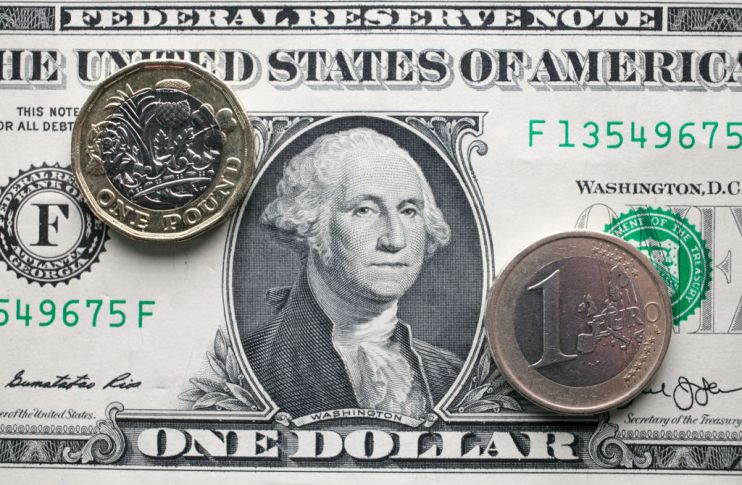US dollar this year has become the only asset in town

Investors have had an insatiable appetite for US dollars this year.
According to the Wall Street Journal’s dollar index, which measures the greenback against a basket of some of the world’s top currencies, the dollar is its strongest for over a decade.
One dollar will buy you the greatest amount of Japanese yen since the early 1990s. The pound recently collapsed to its lowest level against the dollar in nearly 40 years.
Pound has tumbled to historic lows against US dollar this year…

While Wall Street has suffered sharp falls, the currency of the world’s largest economy has strengthened substantially.
“These moves mostly reflect that investors have raised their expectations for near-term [US] rate hikes,” according to consultancy Capital Economics.
The Federal Reserve, the world’s most powerful central bank, has sped ahead of the globe’s other major monetary authorities in the race to tame inflation with interest rate hikes.
Fed chief Jerome Powell and the federal open market committee have lifted rates 225 basis points since March, the quickest cycle since former Fed chief Paul Volcker led the charge against inflation in the 1980s.
Borrowing costs are higher in the US than they are in the UK and eurozone.
US inflation surprised to the upside last month, hitting 8.3 per cent, above markets expected eight per cent rate.
That shock has prompted investors to price in at least a 75 basis point hike on Wednesday, with an outside chance of a full percentage point increase.
Expectations of more super sized US rate rises has boosted the greenback by incentivising investors to buy dollar-denominated assets to capitalise on greater relative returns.
The Bank of England this week may have to hike rates 75 basis points this week to protect sterling, analysts have warned, which would be the steepest move in its 25 years of independence.
…as has the Japanese yen

“Acting even more forcefully could help stem the collapse in the pound,” Sanjay Raja, senior economist at Deutsche Bank, said
In response, the world’s most important capital market has been undergoing a period of adjustment, driven by investors bracing for a tighter monetary policy in the US.
Yields on US treasuries have been on a tear. Returns on the 2-year bond have climbed to their highest level since 2007, forcing the yield curve to invert – when short-term bonds offer a higher return than long-term bonds – often a precursor to a recession.
Yields and prices move in opposite directions due to the return, or coupon, on a bond being calculated as a percentage of the value of the debt.
As prices fall, that return represents a greater proportion of the asset’s value.
Traders have been hoovering up US government debt to get in on the action. But, they have to buy dollars to get access to that debt, which has put upward pressure on the currency.
Markets are pricing in rate cuts from the Fed next year to combat a likely recession, which should unravel some dollar strength.
Soaring inflation is squeezing households and businesses, reducing their capacity to keep the global economy well-oiled.
Higher costs are forcing firms to cut loss-making activities, while consumers are shunning non-essential purchases.
UK retail sales fell again in August, the Office for National Statistics said last week, but across the pond, they unexpectedly jumped, strengthening the case to buy stateside assets.
Surges in inflation typically indicate an economy is demanding things it cannot produce.
In the short-term, consumers lose their spending power due to wages failing to keep pace and businesses scale back costs, typically by shedding workers.
Heaping pain on firms and consumers by hiking interest rates and cutting government spending is the typical textbook response. Markets readjust and prices eventually start falling.
This is the inflection point the global economy finds itself in. The dollar often benefits during times of such economic fragility.
During slumps, investors down tools and pour into assets they know will weather the storm. The dollar, and historically gold, is top of their list of things to buy when de-risking their portfolio.
The cycle of investors pouring into the dollar is a self-fulfilling prophecy. Everyone believes the greenback is a safe bet, which actually makes it a safe bet, causing it to push other currencies down the pecking order.
A large chunk of international trade is denominated in dollars, meaning countries have to stockpile the currency to do business.
This near monopoly of trade means the dollar pretty much always has a demand floor, meaning the likelihood of it weakening substantially is pretty slim.
A stronger greenback also hurts emerging markets as it makes it more expensive for them to service predominantly dollar-denominated debt.
With the Fed expected to keep raising rates rapidly, investors can probably assume the dollar is a safe bet for a few months yet.